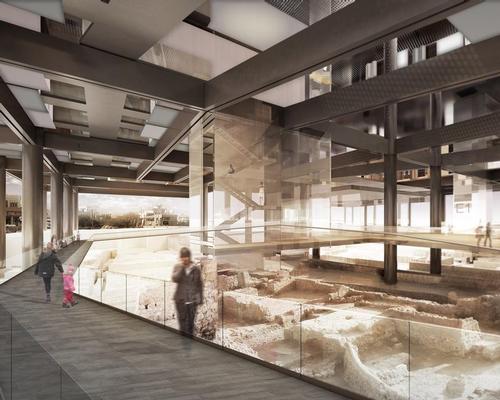21 Dec 2015
Architecture and archaeology mix at museum and hotel hybrid surrounding ancient Turkish ruins
BY Kim Megson

A unique new attraction is set to open in the Turkish city of Antakya by the end of 2016: a museum/hotel hybrid where guests can walk around archaeological ruins dating back more than 2,000 years.
In 2010, international design studio Emre Arolat Architecture had been developing a five-star hotel development on the site, located close to St. Pierre Church – an early centre of Christianity and an important pilgrimage site. However, plans were postponed when excavators discovered an intact 9,000sq ft (836sq m) mosaic tiled floor – one of the largest in the world.
After negotiations with the government and project developer, the architects agreed to change their design for the project in a way that explores the dynamic relationship between architecture and archeology.
In the final structure, hotel guests will sleep above the ancient relics, and the units of the building will protect and promote the ruins below.
“There had to be a dichotomy between an archeological park and the private hotel, and this has become a major input in the design process,” said Emre Arolat Architecture in a statement. “The building has to turn itself inside out to deal with the specific characteristics of this unique situation and place.”
The location of the findings discovered on site has determined the exact location of the structure’s supporting columns. The building – now named the Antakya Hilton Museum Hotel – features a protective platform covering the excavation below.
The platform is occupied by hotel facilities – including a ballroom, swimming pool, spa, fitness centre, nightclub, restaurant and garden terrace – and doubles as an observation point looking out towards the city and church. Slits in the floor act as skylights for the archeological site and create a visual connection between the findings and the hotel amenities.
Meanwhile, the hotel’s guestrooms are located above, contained within prefabricated boxes that sit on top of each other and are supported by a steel substructure. Ramps, walkways and bridges connect these boxes, creating a semi-open space with views down to the ruins below and leading to the ground floor.
A lobby, restaurant and lounge are located in close proximity to the ongoing dig, in addition to the site’s museum. A pathway offers walks around the site, with display boards explaining the history and context of the relics.
“The building is being assembled on site rather than being built there, reminding one of the temporary structures built by archeologists during the excavation,” explained the architects. “This is not a compact, introverted and conventional hotel building.”
When completed, the museum-hotel will be operated by Hilton Hotels & Resorts, who have signed a franchise agreement with local developer ASF Otelcilik ve Turizm Isletmer?i Ticaret.
Close Window